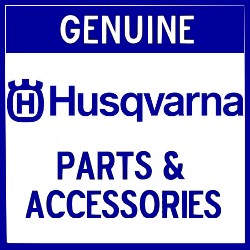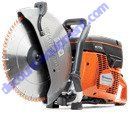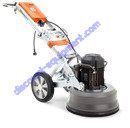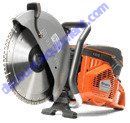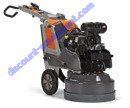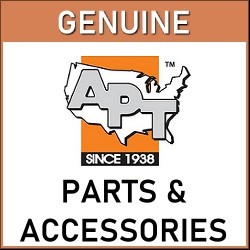Husqvarna CRT 48-57K-PS Ride-on Trowels 970461611 w/ Power Steering and Kubota, 57 HP, WG1605 Engine
Safety Information
Husqvarna CRT 48-57K-PS Ride-On Trowel
Safety Information
Signal Words Used in this Manual
This manual contains DANGER, WARNING, CAUTION, NOTICE, and NOTE
signal words which must be followed to reduce the possibility of personal injury,
damage to the equipment, or improper service.
This is the safety alert symbol. It is used to alert you to potential personal hazards.
► Obey all safety messages that follow this symbol.
DANGER
DANGER indicates a hazardous situation which, if not avoided, will result in death
or serious injury.
► To avoid death or serious injury from this type of hazard, obey all safety messages that follow this signal word.
WARNING
WARNING indicates a hazardous situation which, if not avoided, could result in
death or serious injury.
► To avoid possible death or serious injury from this type of hazard, obey all safety
messages that follow this signal word.
CAUTION
CAUTION indicates a hazardous situation which, if not avoided, could result in
minor or moderate injury.
► To avoid possible minor or moderate injury from this type of hazard, obey all
safety messages that follow this signal word.
NOTICE: Used without the safety alert symbol, NOTICE indicates a situation
which, if not avoided, could result in property damage.
Note: A Note contains additional information important to a procedure.
Safety Information CRT48-PS
Machine Description and Intended Use
This machine is a ride-on concrete finishing trowel. The Wacker Neuson Ride-On
Trowel consists of a frame onto which are mounted a gasoline or diesel engine, a fuel
tank, a water tank, two gearboxes joined by a drive shaft, and an operator’s platform
with controls and a seat. A set of metal blades is connected to each gearbox. A ring
guard surrounds the blades. The engine rotates the blades via the gearboxes and a
clutch mechanism. The rotating blades ride on the surface of curing concrete, creating
a smooth finish. The operator, who sits on the operator’s platform, uses the controls and
the throttle pedal to control speed and direction of the machine.
This machine is intended to be used for floating and burnishing curing concrete.
This machine has been designed and built strictly for the intended use described
above. Using the machine for any other purpose could permanently damage the
machine or seriously injure the operator or other persons in the area. Machine damage
caused by misuse is not covered under warranty.
The following are some examples of misuse:
■ Using the machine as a ladder, support, or work surface
■ Using the machine to carry or transport passengers or equipment
■ Using the machine to finish inappropriate materials such as slurries, sealers, or
epoxy finishes
■ Operating the machine outside of factory specifications
■ Operating the machine in a manner inconsistent with all warnings found on the
machine and in the Operator’s Manual
This machine has been designed and built in accordance with the latest global safety
standards. It has been carefully engineered to eliminate hazards as far as practicable
and to increase operator safety through protective guards and labeling. However, some
risks may remain even after protective measures have been taken. They are called
residual risks. On this machine, they may include exposure to:
■ Heat, noise, exhaust, and carbon monoxide from the engine
■ Chemical burns from the curing concrete
■ Fire hazards from improper refueling techniques
■ Fuel and its fumes, fuel spillage from improper lifting technique
■ Personal injury from improper lifting techniques
■ Cutting hazards from sharp or worn blades
To protect yourself and others, make sure you thoroughly read and understand the
safety information presented in this manual before operating the machine.
Safety Information
Safety Guidelines for Operating the Machine
Operator training
Before operating the machine:
■ Read and understand the operating instructions contained in all manuals
delivered with the machine.
■ Familiarize yourself with the location and proper use of all controls and safety
devices.
■ Contact Wacker Neuson for additional training if necessary.
When operating this machine:
■ Do not allow improperly trained people to operate the machine. People
operating the machine must be familiar with the potential risks and hazards
associated with it.
Operator qualifications
Only trained personnel are permitted to start, operate, and shut down the machine.
They also must meet the following qualifications:
■ Have received instruction on how to properly use the machine
■ Are familiar with required safety devices
The machine must not be accessed or operated by:
■ Children
■ People impaired by alcohol, drugs, or prescription drugs
Application area
Be aware of the application area.
■ Keep unauthorized personnel, children, and pets away from the machine.
■ Remain aware of changing positions and the movement of other equipment and
personnel in the application area/job site.
■ Identify whether special hazards exist in the application area, such as toxic
gases or unstable ground conditions, and take appropriate action to eliminate
the special hazards before using the machine.
■ Do not operate the machine in areas that contain flammable objects, fuels, or
products that produce flammable vapors.
Dust precaution
Dust created by construction activities may cause silicosis or respiratory harm. To
reduce the risk of exposure:
■ Work in a well ventilated area.
■ Use a dust control system.
■ Wear an approved dust/particle respirator.
Safety devices, controls, and attachments
Only operate the machine when:
■ All safety devices and guards are in place and in working order.
■ All controls operate correctly.
■ The machine is set up correctly according to the instructions in the Operator’s
Manual.
■ The machine is clean.
■ The machine’s labels are legible.
To ensure safe operation of the machine:
Safety operating practices
■ Do not operate the machine if any safety devices or guards are missing or
inoperative.
■ Do not modify or defeat the safety devices.
■ Only use accessories or attachments that are approved by Wacker Neuson. Safe
operating practices
When operating this machine:
■ Remain aware of the machine’s moving parts. Keep hands, feet, and loose
clothing away from the machine’s moving parts.
■ Do not operate a machine in need of repair.
■ Do not consume the operating fluids used in this machine. Depending on your
machine model, these operating fluids may include water, wetting agents, fuel
(gasoline, diesel, kerosene, propane, or natural gas), oil, coolant, hydraulic oil,
heat transfer fluid (propylene glycol with additives), battery acid, or grease.
Personal Protective Equipment (PPE)
Wear the following personal protective equipment (PPE) while operating this
machine:
■ Close-fitting work clothes that do not hinder movement
■ Safety glasses with side shields
■ Hearing protection
■ Safety-toed footwear
After use
■ Stop the engine when the machine is not being operated.
■ Close the fuel valve on engines equipped with one when the machine is not
being operated.
■ Ensure that the machine will not tip over, roll, slide, or fall when not being
operated.
■ Store the machine properly when it is not being used. The machine should be
stored in a clean location out of the reach of children.
Service Safety
Service training
Before servicing or maintaining the machine:
■ Read and understand the instructions contained in all manuals delivered with
the machine.
■ Familiarize yourself with the location and proper use of all controls and
protective devices.
■ Only trained personnel shall troubleshoot or repair problems occurring with the
machine.
■ Contact Wacker Neuson for additional training if necessary.
When servicing or maintaining this machine:
■ Do not allow untrained or improperly trained people to service or maintain the
machine. Personnel servicing or maintaining the machine must be familiar with
the associated potential risks and hazards.
Precautions
When servicing or maintaining the machine:
■ Read and understand the service procedures before performing any service to
the machine.
■ All adjustments and repairs must be completed before operating the machine.
Do not operate the machine with a known problem or deficiency.
■ All repairs and adjustments shall be completed by a qualified technician.
■ Turn off the machine before performing maintenance or making repairs.
■ Remain aware of the machine’s moving parts. Keep hands, feet, and loose
clothing away from the machine’s moving parts.
■ Reinstall the safety devices and guards after repair and maintenance
procedures are complete.
Machine modifications
When servicing or maintaining the machine:
■ Use only accessories/attachments that are approved by Wacker Neuson.
■ Do not defeat safety devices.
■ Do not modify the machine without the express written approval of Wacker
Neuson.
Replacing parts and labels
■ Replace worn or damaged components.
■ Replace all missing and hard-to-read labels.
■ When replacing electrical components, use components that are identical in
rating and performance to the original components.
■ When replacement parts are required for this machine, use only Wacker
Neuson replacement parts or those parts equivalent to the original in all types of
specifications, such as physical dimensions, type, strength, and material.
Cleaning
When cleaning and servicing the machine:
■ Keep machine clean and free of debris such as leaves, paper, cartons, etc.
■ Keep labels legible.
■ Clean with soapy water only.
When cleaning the machine:
■ Do not clean the machine while it is running.
■ Never use gasoline or other types of fuels or flammable solvents to clean the
machine. Fumes from fuels and solvents can become explosive.
Personal protective equipment (PPE)
Wear the following Personal Protective Equipment (PPE) while servicing or
maintaining this machine:
■ Close-fitting work clothes that do not hinder movement
■ Safety glasses with side shields
■ Hearing protection
■ Safety-toed footwear
In addition, before servicing or maintaining the machine:
■ Tie back long hair.
■ Remove all jewelry (including rings).
WARNING
Internal combustion engines present special hazards during operation and fueling.
Failure to follow the warnings and safety standards could result in severe injury or
death.
► Read and follow the warning instructions in the engine owner’s manual and the
safety guidelines below.
DANGER
Exhaust gas from the engine contains carbon monoxide, a deadly poison.
Exposure to carbon monoxide can kill you in minutes.
► NEVER operate the machine inside an enclosed area, such as a tunnel, unless
adequate ventilation is provided through such items as exhaust fans or hoses.
Operating safety
When running the engine:
■ Keep the area around the exhaust pipe free of flammable materials.
■ Check the fuel lines and the fuel tank for leaks and cracks before starting the
engine. Do not run the machine if fuel leaks are present or the fuel lines are
loose.
■ Do not smoke while operating the machine.
■ Do not run the engine near sparks or open flames.
■ Do not touch the engine or muffler while the engine is running or immediately
after it has been turned off.
■ Do not operate a machine when its fuel cap is loose or missing.
■ Do not start the engine if fuel has spilled or a fuel odor is present. Move the
machine away from the spill and wipe the machine dry before starting.
Refueling safety
When refueling the engine:
■ Clean up any spilled fuel immediately.
■ Refill the fuel tank in a well-ventilated area.
■ Reinstall the fuel tank cap after refueling.
■ Do not smoke.
■ Do not refuel a hot or running engine.
■ Do not refuel the engine near sparks or open flames.
■ Use suitable tools for refueling (for example, a fuel hose or a funnel).
■ Do not refuel if the machine is positioned in a truck fitted with a plastic bed liner.
Static electricity can ignite the fuel or fuel vapors.
Safety Guidelines for Lifting the Machine
When lifting the machine:
■ Make sure slings, chains, hooks, ramps, jacks, forklifts, cranes, hoists, and any
other type of lifting device used is attached securely and has enough weightbearing capacity to lift or hold the machine safely. See the Technical Data
chapter for machine weight.
■ Remain aware of the location of other people when lifting the machine.
■ Only use the lifting points and tie-downs described in the Operator’s Manual.
■ Make sure the transporting vehicle has sufficient load capacity and platform size
to safely transport the machine.
To reduce the possibility of injury:
■ Do not stand under the machine while it is being lifted or moved.
■ Do not get onto the machine while it is being lifted or moved.
Hydraulic Oil Safety
WARNING
Possibility of severe injury. Hydraulic oil is under high pressure and becomes very
hot during operation.
► To avoid injury, obey the safety instructions listed below
Safety instructions
■ Inspect the hydraulic system thoroughly before operating the machine.
■ Do not touch hydraulic oil or hydraulic components while the machine is
operating. Wait until the machine is cool.
■ Before disconnecting hydraulic fittings or hoses, ensure that all pressure has
been bled from the circuit. Set all controls in neutral, turn the engine off, and
allow the fluids to cool before loosening hydraulic fittings or attaching test
gauges.
■ Hydraulic oil escaping under high pressure may penetrate the skin, causing
burns, blindness, or other serious injuries or infections. Contact a physician
immediately for treatment if your skin has been penetrated by hydraulic oil, even
if the wound seems minor.
■ Fluid leaks from small holes are often practically invisible. Do not use your bare
hands to check for leaks. Check for leaks using a piece of cardboard or wood.
■ Hydraulic oil is extremely flammable. Stop the engine immediately if a hydraulic
leak is detected.
■ After servicing the hydraulics, make sure all components are reconnected to the
proper fittings. Failure to do so may result in damage to the machine and/or
injury to a person on or near the machine. |

